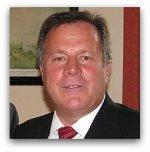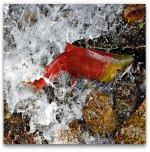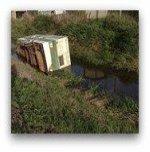Report blames Ottawa for sockeye peril October 7, 2008VANCOUVER -- A combination of ignorance and neglect by the Canadian government appears to be pushing many British Columbia sockeye runs toward extinction, according to a new report by the world's leading conservation group. The report recommends a halt to traditional commercial fishing and reconsideration of artificial spawning programs -- saying both policies are likely contributing to a sockeye decline that is greater here than anywhere else in the world. Sockeye populations in Russia and Alaska are for the most part thriving, notes the report from the International Union for the Conservation of Nature. The IUCN describes its report as a "wakeup call" for B.C. -- the prized salmon could soon find themselves on the global red list for threatened and endangered species. It is the first time that the 60-year-old IUCN, which maintains the world's authoritative list for endangered species, has reviewed Pacific salmon. "It's a loud clarion bell indicating that we need to act right away to conserve these sockeye, which are really the economic and cultural backbone of our salmon fisheries on this coast," said Craig Orr, executive director of Watershed Watch Salmon Society. Orr said the "stressors" on B.C salmon are well known -- warmer river temperatures during migration; mixed-stock fishing that causes weak runs of sockeye to be intercepted with strong ones; ongoing habitat degradation; and fisheries conservation policies that lack the muscle to protect fish. The IUCN says the report is based on "the largest collection of data ever assembled on salmon abundance, coming from 243 spawning locations across the Pacific Rim." The report found that the sockeye species is stable at a global level but noted that 25 per cent of runs into individual rivers are either threatened or endangered. "Most of the critically endangered sockeye runs are in British Columbia, where dramatic declines have occurred in stretches of the Fraser and Skeena rivers," the report says. It says that Fisheries and Oceans Canada should be "encourage[d]" to fully implement its Wild Salmon Policy, relocate salt water fisheries to small upstream locations, do a thorough job of tracking spawning salmon and reconsider artificial spawning programs. Pete Rand, lead assessor for the IUCN salmonid specialist group, said most of the threats can be resolved. "Mixed stock fishing in particular is a problem that is resulting in a higher threat to some populations, especially the smaller populations," he said. The Fisheries Department issued a brief statement, saying it welcomes independent scientific research, and "will be carefully evaluating the IUCN report to see if it offers insights that could enhance the conservation and sustainable use of salmon stocks in B.C." Scott Simpson |
 Minister Doucet
First Nations call for fishing action October 7, 2008 |
 Fraser sockeye returns lowest in 50 years September 09, 2008 Fraser River sockeye returns appear to be at their lowest ebb in 50 years, Fisheries and Oceans Canada said Monday. This summer's returns are already the lowest in the four-year cycle of migrating Fraser-system sockeye, with an average return since 1958 of 4.4 million of the prized salmon on this cycle. This year is 60 per cent below that amount -- 1.7 million fish -- fisheries department's salmon team leader, Paul Ryall, said in a telephone interview. The parent group for this year's return, which migrated into the Fraser system and spawned in 2004, was similarly weak at about 1.9 million fish. Other than a brief opening for commercial and recreational fishermen in July, and some catch by U.S. fishermen under the Pacific Salmon Treaty, the only appreciable fishing has been by first nations for food, societal and ceremonial purposes. The commercial and sport fisheries were authorized when a brief July bump in migration created an impression that a major run had arrived off the southern coast of Vancouver Island . But when it became evident that the run was in fact exceptionally weak, the department quickly shut the fishery down. "It became clear that the fish just weren't there, and we closed any further commercial opportunities," Ryall said. The department warned as long ago as December 2007 that this year's run would be exceptionally weak, based on a low number of fish -- 521,000 -- that made it back to spawning grounds four years ago to birth this year's run. Poor marine survival is also considered a key factor for the continuing struggles of the species -- the survival rate for young salmon to mature to adulthood and return to spawn can run to five per cent, or even higher in a year in which the ocean is a lush, nourishing environment. Ryall said the department estimates this year's run had a survival rate of only about one per cent from the time they hatched and migrated down to the ocean, to the time they made their way back to the river as adults. It's not entirely clear what's causing the survival problem -- everything from climate change and shifting ocean currents to ocean acidification have been considered potential culprits. What is certain is that both Alaskan and Russian sockeye populations are thriving even as B.C.'s struggle, and that Fraser sockeye also continue to exhibit unanticipated migratory behavior -- moving out of the ocean and into the Fraser River about five days earlier than usual. There is a bit of good news in this -- for the fish, if not for the people who like to eat them. In anticipating this year's weak run, the department consulted over a period of months with first nations living along the sockeye's migration area in the Strait of Georgia and Johnstone Strait , as well as aboriginals living along the Fraser itself, and commercial and sport groups -- bracing them in advance for a bad year. In a typical year, first nations take 800,000 to one million sockeye out of the Fraser, but this year the department limited their fishing and they've only caught 400,000. As a consequence, the expected number of fish that will escape human predation and make it back to spawning grounds is about 1.2 million. That's an improvement over the 50-year average escapement of 822,000. Scott Simpson |

Trailer fuel likely behind Surrey "fish kill" September 28, 2008
Leaking fuel from a submerged trailer is believed to be behind a spill that killed dozens of fish in a Surrey creek over the weekend. A road near Harvie Road and 80th Avenue was closed for several hours yesterday as crews laid out booms on the water to prevent the slick from spreading to nearby waterways. "The Hazmat team has done an excellent job of protecting the environment by securing the product into the location where it is now," said Surrey Fire Chief Keith Boswell. "It's not travelling any further." Several B.C. environment agencies have been notified. Officers say the trailer will be removed as final clean-ups take place on Monday. It's not clear how the trailer got there, and firefighters have tried once already to remove it. The RCMP are investigating why the trailer was put in the creek. ctvbc.ca |

Fisheries dispute erupts in Fraser Canyon September 15, 2008 VANCOUVER -- A controversial treaty that would give a small native band control of access to salmon in the Fraser Canyon has come under fire from another first nation. The Yale Indian Band is claiming sole ownership of fishing grounds that other bands have long used in the canyon, said Grand Chief Clarence Pennier of the Sto:lo First Nation. He said that if the treaty is finalized as now drafted, it will lead to increased friction among aboriginals on the fishing grounds. There have already been fist fights and weapons brandished, Mr. Pennier said, as Yale members have sought to evict Sto:lo fishermen from the canyon. "Yale wants to control the whole area on their own. Some people have been threatened up there. There have been fights and some people have stopped going there to fish." Under the B.C. Treaty Process, the Yale band reached an agreement in principle that would give them more than 1,000 hectares of land, $6.5-million in cash, an allocation of the annual salmon catch on the Fraser River and self-government provisions. The agreement also states that the Yale band "may regulate public access to their treaty settlement lands to prevent harvesting of resources owned by Yale First Nation, to prevent nuisance or damage, and to protect culturally and environmentally sensitive areas." Mr. Pennier said the effect of that clause is that Sto:lo fishermen, who for generations have gone up into the canyon to catch salmon, could be blocked from family fishing sites. A Sto:lo position paper that analyzes the Yale agreement calls the settlement "both disturbing and deplorable" because of the potential impact on fishing rights, and because Kuthlalth Indian Reserve 3 has been assigned to the Yale band from a neighbouring Sto:lo band. Mr. Pennier said Kuthlalth has long been claimed by the Sto:lo. "There is an old [Sto:lo] village site on Kuthlalth. Yale wants to change history." He said he has taken his complaints to the federal and B.C. governments. B.C.'s Aboriginal Relations Minister Mike de Jong declined to comment, referring questions to federal officials. Catherine Blackstock, acting manager of the consultation unit for Indian and Northern Affairs Canada, said the concerns raised by the Sto:lo have been noted. "We're continuing our discussions with overlap first nations whose aboriginal interests may be impacted by the Yale first nations treaty, as well as third parties whose interests may be affected," she said. Ms. Blackstock said the agreement in principle was signed with the Yale band in 2006, and a final treaty is now close. "But there is more work required before the final agreement is in place, and you know, of course, one of those things [remaining] is working on the overlap issues." Neither Yale Chief Robert Hope, nor Beatrice Bonneau, treaty co-ordinator for the band, returned phone calls. Ernie Crey, the Sto:lo Tribal Council's fisheries adviser, said some Yale members have been trying to assert ownership over the canyon in advance of the treaty by "waving guns" at Sto:lo fishermen. "They are trying to run non-band members out of the canyon and assert complete control," he said. The fishing season is now over, but Ken Malloway, a Sto:lo fisherman who claims a traditional family site in the canyon, said he has been threatened more than once and has seen a few fist fights. Mr. Malloway said he continued to use his fishing spot this summer, but others stopped going to the area. "They don't scare me," he said of those trying to force Sto:lo fishermen from the river. "If seven of them come up in a boat and threaten me, I'll jump right in their boat." He said the canyon, near Yale, has the best fishing water on the Fraser. "The river narrows in the canyon. ... Virtually all of the stocks go through there and it's easier to catch them in the fast water because they rest in the eddies," he said. "It's the most lucrative fishing place there is - and they want it all," he said of the Yale band. "They are trying to get us out and they are using the treaty process to do it." Mr. Malloway added: "We could never understand how the government could negotiate that treaty with them." He is urging Sto:lo leaders to "do whatever we have to do to stop that treaty." The agreement in principle was the fifth stage of a six-stage treaty process. Meetings to arrive at a final treaty have been taking place this month. Mark Hume |

|
UFFCA.pdf Size : 0.116 Kb Type : pdf |

|
Stellaten First Nation.pdf Size : 0.313 Kb Type : pdf |

|
Stolo Fraser Sockeye Runs.pdf Size : 0.11 Kb Type : pdf |

|
UFFCA Response.pdf Size : 0.075 Kb Type : pdf |

St’át’imc say NO to status quo fishery July 23, 2008
Throughout the winter, beginning in January, the Department of
Fisheries and Oceans was propagandizing a fear mongering campaign where
indigenous nations were essentially being told to share their fish with
other groups due to an expected shortage of salmon stocks, especially
in the Fraser Watershed. As a leader of the St’át’imc people I have
advocated that as long as the commercial industry and the recreational
fishing industry were curtailed as per the law respecting this matter
our respective peoples should be able to fish and acquire their supply
of winter food.
We, the indigenous people also emphasized that we will not target the
early Stuart and early summer stocks for harvesting in order to
facilitate escapement to the northern indigenous nations to harvest
some of their stocks of salmon. This practice has been a policy of our
nations over the last three decades. As no significant results have
materialized the indigenous nations took action to actuate a treaty,
signed in 1989, and Inter-Tribal Fishing Treaty to take control of the
management and conservation of the fish stocks in the Pacific Region,
especially the Fraser watershed. The St’át’imc of the Mid-Fraser area took the foregoing to heart and collectively arranged to delay their fish harvesting to July 28, 2008, in order that up-river nations may have more salmon to harvest as well as providing greater escapement to the spawning grounds. Recently a phone call was taken by me from D.F.O. which signaled that they wished to open up the fishery earlier as there was an indication of more fish returning than expected. I am recommending to the Northern St’át’imc Fishery that we not alter our plans but permit the increased number of salmon to pass for the benefit of up-river people and the spawning grounds. If we are serious about conservation and enhancement then we must all walk our talk. Grand Chief Saul Terry, St’át’imc Nation Inter-Tribal Fishery Treaty Spokesman |
